Introduction
Pre-revolutionary Russian Imperial State Publications
Spravochniki po istorii dorevoliutsionnoi Rossii. Bibliograficheskii ukazatel’
Zaionchkovskii, P.A. 2 nd ed. Moskva: Kniga, 1978. 640 p. U of I Library Call Number: International & Area Studies Russian Reference (Slavic) and Main Stacks 016.947 Sp76 1978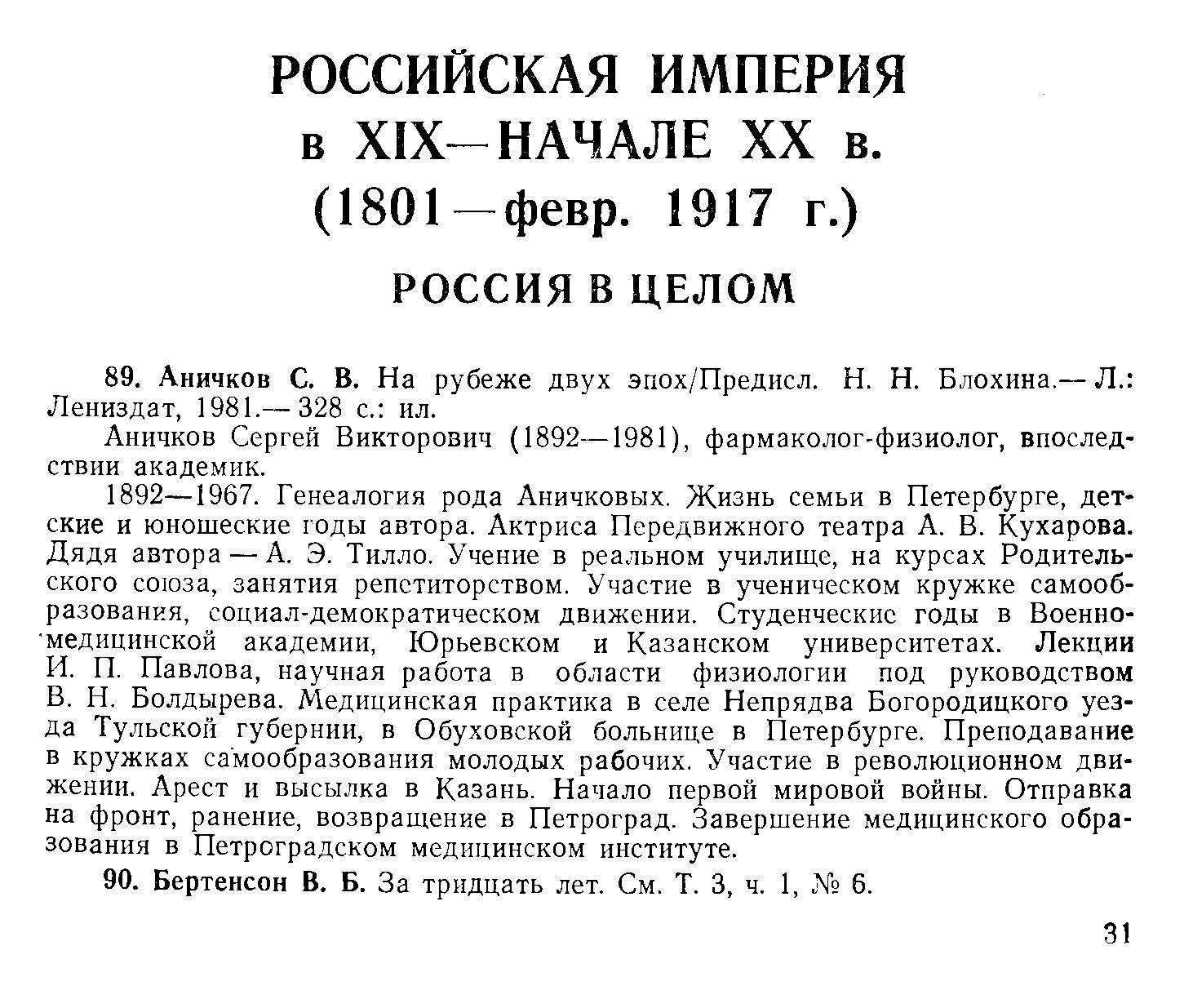
This excellent bibliography covers historical material on the history of Russia from the 15th century to February 1917 and is an excellent source of information on government publications of all kinds: laws, censuses, ministry publications, statistical data, etc. The first section covers general reference works such as encyclopedias, dictionaries, atlases, necrologies, and archival guides. The rest of the guide is divided into broad subject areas and then subdivided into specific topics that are outlined in the table of contents. The broad subject headings are Social and Economic Affairs, Political Affairs, Military Affairs, Sociopolitical Movements in the 19th and 20th c., Science and Education, and Regional Administrative Affairs. Most entries are annotated. Zaionchkovskii used the collections of several libraries, including GPIB, the Ermitazh library, and the catalog of the Tsentralnyi gosudarstvennyi arkhiv drevnikh aktov for material before the 18th c. Works on archaeology and ethnography are not included, nor are works related to the history of literature, art, museum studies, or bibliography. However, publications with the activities and membership of societies devoted to these subjects are listed.
This entry gives a good idea of the kind of information one can expect to find in Zaionchkovskii. For those looking for information on the membership of a certain organization, academic institution, military unit or government agency, Zaionchkovskii will provide the most complete list of resources. The types of sources are quite different from those you will find on the same topic in a source like Istoriia SSSR. A general index of subjects, governmental bodies, organizations, and institutions concludes the book and aids in locating materials on very specific topics.
Pervaia vseobshchaia perepisʹ naselenīia Rossiiskoi Imperii, 1897 g. “Izd. TSentr. stat. komiteta Ministerstva vnutrennikh diel.”
N.A. Troĭnitskii. Sankt-Peterburg: TSentralʹnyi statisticheskii komitet. 1897-1905. U of I Library Call Number: Main Stacks 312.47 R923pe.
As the only empire-wide census conducted prior to the Soviet era, the General Census of 1897 is a good place to start a review of pre-revolutionary Russian government documents. The general census of 1897 is a large, multi-volume set that has been digitized and is available at: http://brittlebooks.library.illinois.edu/brittlebooks_open/Books2009-08/russia0001nassta/. In addition, a bound overview is available at the U of I International and Area Studies Reference collection at the Dewey number listed above as well.
Research Guide to the Russian and Soviet Censuses
Clem, Ralph S. ed. Ithaca, NY: Cornell University Press, 1986. U of I Library Call Number: International & Area Studies Russian Reference (Slavic) 304.60947R311
This specialized and thorough guide is extremely useful for anyone requiring to make sense of the art of Russian census design and execution. The edited guide is comprised of eight chapters that address the main interests of specialists relying on census data: the history of Russian and Soviet censuses, ethnic and language dimensions in census design, occupational, migration, urban/rural, and education/literacy data. The added perspective is invaluable to researchers to understand the information gathering process: in the section on ethnicity, for example, the author compares over time the instruction given to census takers on how nationality is defined by the state. An additional and lengthy section breaks down the individual censuses of the late empire and Soviet Union, from 1897 to 1979. This section is very detailed, basically an annotated description of the censuses addressing each major point along the way.
Katalog: Russkie ofitsial’nye i vedomstvennye izdaniia XIX-nachala XX veka.
Comp. E. K. Avramenko, N. G. Markova, and N. E. Kaschenko. Russkii gosudarstvennyi istoricheskii arkhiv. Nauchno-spravochnaia biblioteka. St. Petersburg: BLITS, 1995- Vols. 1-6 (1995-99). U of I Library Call Number: International & Area Studies Russian Reference (Slavic) and Oak Street Facility 025.3434 K155
This is a multi-volume catalog of of official and departmental publications from the last decades of the Russian Empire based on the card catalog of the reference library of the Russian State Historical Archive/RGIA. It includes full bibliographic descriptions of legislative acts, directives, circulars, annual reports, budgets, jubilee publications, and monographic research promulgated or submitted by the Imperial and Provincial administrations before their end in October 1917. Since some of these materials are already covered in Zaionchkovskii’s Spravochniki po istorii dorevoliutsionnoi Rossii (above), they are presented in abbreviated form here. Volumes one through five were published within two years, while volume six was released two years later to end the series. Vol. 1 covers the State Council, State Duma, Council of Ministers, Senate and Holy Synod; vol. 2 the Interior, War and Navy Ministries; vol. 3 the Ministries of Agriculture, Imperial Court, Foreign Affairs, and Education; vol. 4 focuses on the Transportation Ministry; vol. 5 the Ministries of Commerce, Industry, Finance, and Justice. The final volume is a bibliography of publications issued by institutions that were not subordinate to any ministry, and both public and private cultural organizations and associations. There are some incomplete listings because the catalog is based only on the holdings of the State Historical Archive.
Publications of Russian Imperial Government Ministries
While by no means an exhaustive list, the following are examples of publications from the Imperial period from the various ministries of the Russian Government in St. Petersburg, as well as publications of the legislative assembly created after the 1905 revolution, the State Duma.
Ukazatel’ knig, zhurnal’nykh i gazetnykh statei po sel’skomu khoziaistvu. Otdel sel’skoi ekonomii i sel’skokhoziastvennoi statistiki.
Glavnoe Upravlenie zemleustroistva I zemled.
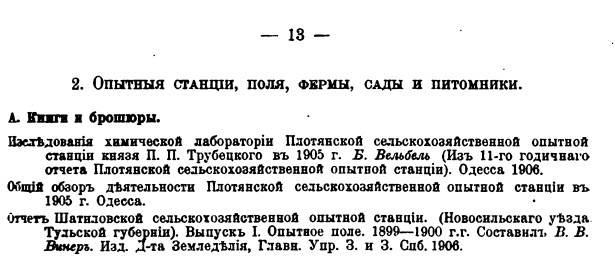
S.-Peterburg: Tipografiia V.F. Kirshbauma. 1884-1911.
This bibliographic guide on pre-revolutionary agricultural economic issues, the guide of the Agricultural Economics and Rural Industry Section, published annually between 1884 and 1911, includes journal and newspaper articles on a range of issues connected to government oversight of agriculture. The 1906 edition is available online via the Hathi Trust at: http://hdl.handle.net/2027/uc1.b3106714 .
Sbornik konsul’skikh donesenii. Ministerstvo inostrannykh del.
S.-Peterburg: Skoropechatnia “Nadezhda.” 1861-1917. U of I Library Call Number: Main Stacks 327.47 r92s, 1898-1910.
In the realm of international affairs, the former is the annual review published by the Ministry of Foreign Affairs of the Russian Empire on Russian diplomatic decisions and international relations from the liberation of the serfs to the last full year of Imperial rule. It is the main publication of the Imperial government on this topic, but not available at U of I. The latter publication is available at U of I for two of the twelve years it was published, 1909-1910, in book form, but the full thirteen years are available in microfiche. The Russian Foreign Ministry in fact published a wealth of documents during much of the half century preceding the collapse of the empire in 1917. It can be confusing to make sense of this range of materials, but nonetheless it is useful for scholars to know the wealth of materials available.
Parliamentary Publications
Gosudarstvennaia Duma: Stenograficheskii Otchet.
Sankt Peterburg: Gosudarstvennaia tipografiia, 1907. U of I Library Call Number: International & Area Studies Microform (Slavic) Microcard 947.
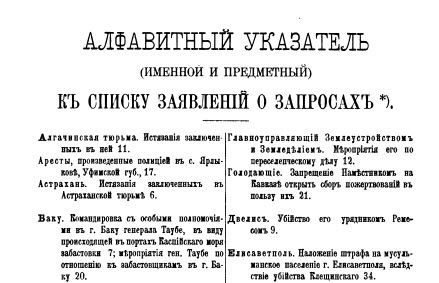
This is the record of debates, issues, and decrees of the Russian Imperial Duma beginning in 1906 and continuing through its disbanding in 1917 by the Bolsheviks. The entire record is available online at HathiTrust for participating institutions: http://catalog.hathitrust.org/Record/011262122 . It is also available in microcard format in the U of I Slavic microfiche and film room. While microcards can be challenging to use, records for the first, second and third Dumas are in many was far more relevant than the records of the Tsar’s rubber stamp that was the Fourth Duma, available below. The records are organized in accordance with the sessions of the Duma itself, such that much more information is available for the Third and Fourth Dumas, which met more often for longer. Throughout the annual records are indexes of the proceedings organized several different ways depending on the topic, the decree and/or decisions in question, and the geographical area or government institution concerned. It is important to use the table of contents at the beginning of any index volume or one can easily get lost in the massive tables listing proceedings content.
Nakaz Gosudarstvennoi Dumy.
Petrograd: Gosudarstvennaia Tipografiia, 1915. U of I Library Call number: History, Philosophy, & Newspaper FILM 328.47 R921n
This is the printed newsletter outlining the full annual decrees of the Fourth State Duma that met from 1912-1917, followed by a tremendously thorough, cross-referenced subject index for all the entries that exceeds the length of the actual collection of decrees. U of I has the 1915 edition.
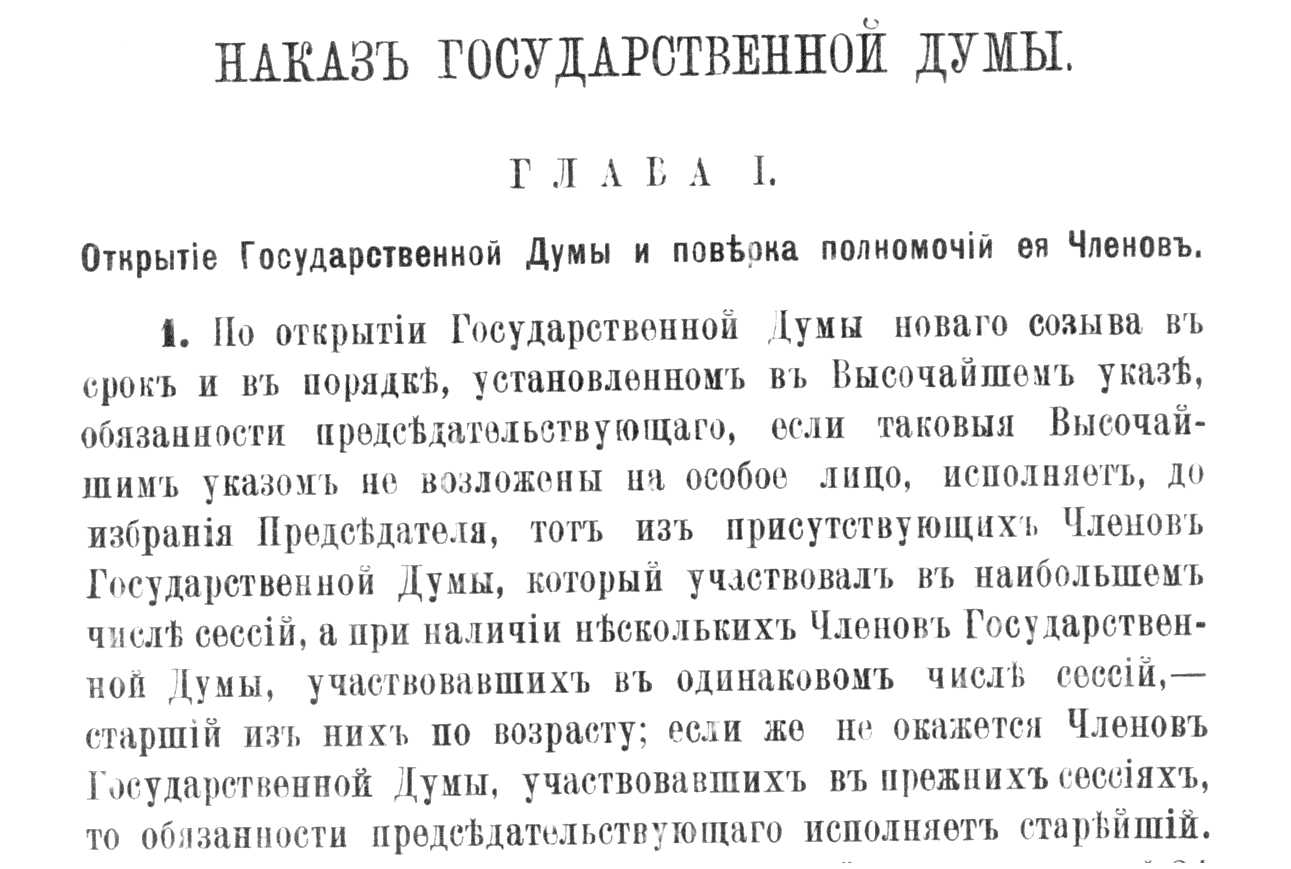
Publications of the Provisional Government (1917)
Viestnik Vremennago Pravitel’stva. Ministerstvo vnutrennikh del.
Petrograd: Zdanie M-va vnutr. dielʺ, 1917. U of I Library Call Number: History, Philosophy, & Newspaper FILM 320.94705 VI.
The official publication of the Provisional Government was published daily between the abdication of the Tsar on March 5 and just prior to the siege of the Winter Palace by the Bolsheviks, on October 26, in all 186 daily editions. The paper covers in detail all the decisions of the Provisional Government, presents the local news for Petrograd and in certain cases of other cities, and discusses the decrees of the municipal government as well.


Soviet Government Publications
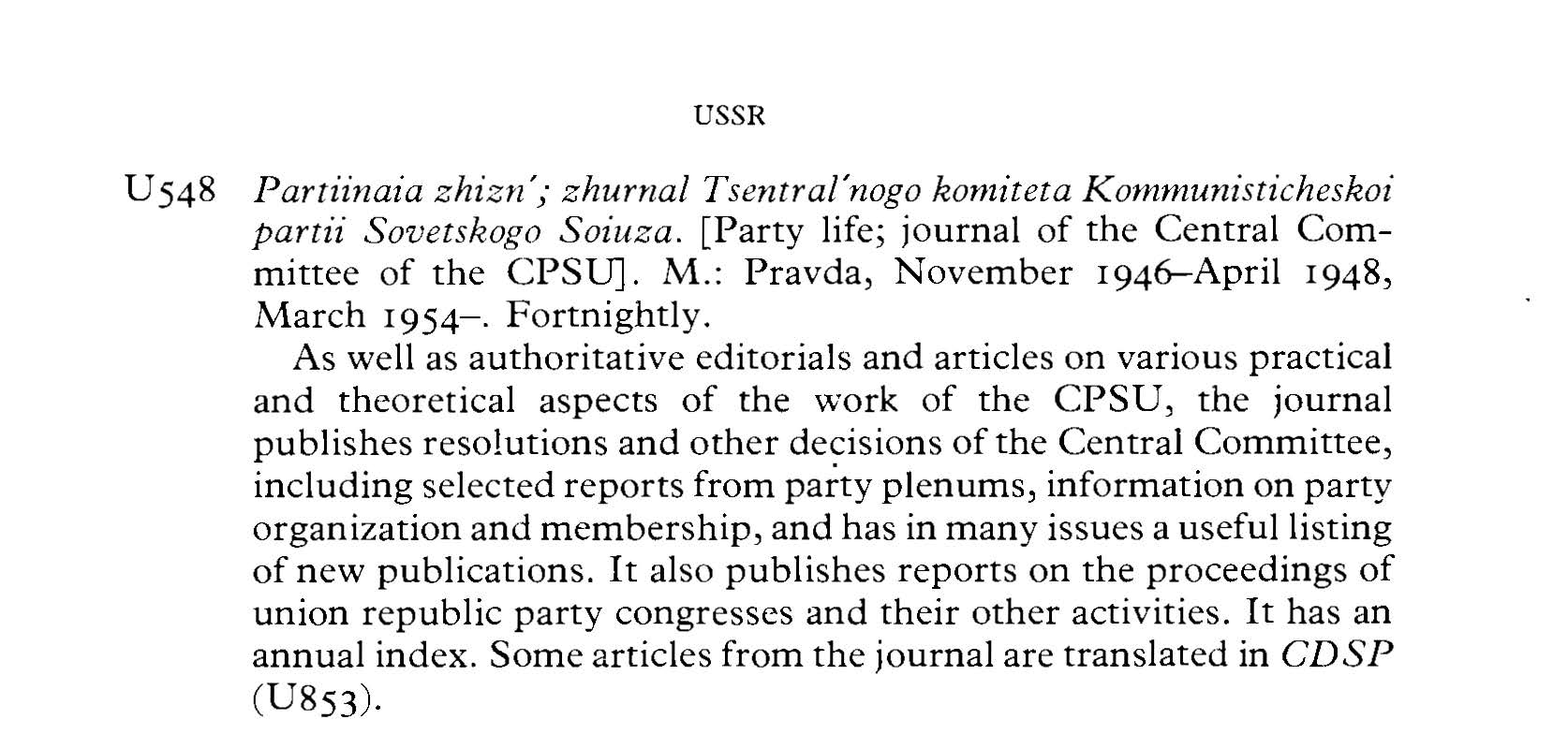
Official Publications of the Soviet Union and Eastern Europe, 1945-1980.
An excellent bibliographic guide for state publications during the majority of the post-war socialist era for the entire communist region, in English. Includes an introduction to the materials, a breakdown of bibliographic sources by subject area, and then a longer and more in-depth section of publications by country. Individual country bibliographies are also broken down by subject area, including general works, constitutional documents, law and judicial system, Supreme soviets and governments, Communist Party, general statistics, other documentation sources, international relations, military affairs, economic affairs, social affairs, cultural affairs, and leaders’ works.
Svod zakonov SSSR. Prezidium Verkhovnogo Soveta SSSR, Sovet Ministrov SSSR.
Moskva: “Izvestii︠a︡”, 1980. U of I Library Call Number: Law Compact Stacks [non-circulating] KLA12 .S68
This is the official publication of the Presidium of the Supreme Soviet of the USSR and the Council of Ministers. It includes legislation, joint ordinances of the Council of Ministers of the USSR and the Central Committee of the CPSU. The twelve volume set is dived thematically by subject. Volume 1 addresses legislation on the social and state system; Vol. 2, marriage, family, labor and social security; Vol.3, health, sport, education, science, and legal standing of foreigners; Vol.4, natural resources; Vol.5, economy and financial law; Vol.6, construction; Vol.7, industry; Vol.8, agriculture; Vol.9, transport, communication, trade, and housing; Vol.10, international relations, foreign trade, defense and border control; Vol.11, justice and legal order. Vol.12 is the index for the entire publication.
KPSS o rabote sovetov : sbornik dokumentov. Communist Party of the Soviet Union.
Moskva: Gos. izd-vo polit. lit-ry, 1959. U of I Library Call Number: Main Stacks 947.08 K837K
This is the collection of documents by the Communist Party Central Committee, detailing all its resolutions and decisions concerning sessions beginning in 1906 through the late 1950s. The programs of the most important decision taken by the Bolshevik and eventually Communist Party during this formative era, including the setting up of the Soviet government framework during the 8th RKP(b) in 1919, is detailed in this review of the work of the soviets, from central to regional and local levels. All the issues of socialist life and state building, from foreign affairs to agriculture to industry to the nationalities question to village taxation, are covered in this document collection.

Sovety narodnykh deputatov.
Moskva: Izvestiia, 1957-93. U of I Library Call Number: Main Stacks 352.047 SO89 (1957-77); 352.047 SO891 (1977-89); 320.85405NA (1989-93, as Narodnyi deputat).
Beginning in 1957 and lasting a few years after the collapse of the Soviet Union (the successor publication to KPSS o rabote sovetov), this monthly state journal put out by Izvestiia publishing house in Moscow covered the work of the USSR Supreme Soviet, the republic supreme soviets and the regional and local soviets. As it pertains only to the USSR Supreme Soviet, this journal also deals with some Permanent Commissions and the work of some of its delegates. An index accompanies the last volume of every year.
Publications of Soviet Government Ministries
Diplomaticheskii vestnik. Ministerstvo inostrannykh del.
Moskva: Diplomaticheskaia akademiia. 1982-1989. U of I Library Call Number: Main Stacks 327 D62521982. In the realm of international affairs, the Diplomatic Academy of the Ministry of Foreign Affairs published this annual edited journal on international relations, world global politics and the ideological question in international affairs. This is an important collection of essays representing the official perspective on international affairs from the Soviet perspective in the waning days of the USSR. The journal was an important scholarly source of international politics more broadly, containing a section that reviewed new books in field as well as important conference on the topic within the socialist bloc. Every issue also included a chronology of important events on the international and diplomatic fronts from the official Soviet perspective, and an appendix with selected “answers” written by Pravda editors to “questions” posed by the public directed to the General Secretary of the Communist Party Central Committee.

Soviet RSFSR
Sovetskaia Rossiia: Biuro TSK KPSS po RSFSR I Soveta Ministrov RSFSR.
Moskva: Biuro TSK KPSS po RSFSR I Soveta Ministrov RSFSR.
U of I Library Call Number: History, Philosophy, & Newspaper FILM 057.1 SOVRS. U of I has most years on film between 1956 and 2006
This is the official daily (except Mondays) news publication of the Supreme Soviet of the RSFSR that was published beginning in 1956 until the collapse of the USSR in 1991. It has continued to be issued until 2006 under the same name, even though there is no longer much that is Soviet about the Russian Federation.
Sobrania uzakonenii i rasporiazhenii raboche-krest’ianskogo pravitel’stva.
U of I Library Call Number: History, Philosophy, & Newspaper FILM 340.0947 So128
As the official law gazette of the RSFSR state government beginning in 1922, issued by the RSFSR People’s Commissariat of Justice, this publication went through numerous name changes that directly affect its ease of location as a source. It was called the Sobranie postanovlenii i rasporiazhenii pravitelstva RSRSR until 1948, after when it became the Sobranie postanovlenii i rasporiazhenii Soveta Ministrov RSFSR. Beginning in 1958, the title was simplified to the Sobranie postanovlenii pravitelstva RSFSR.
Post-Soviet Russian Federation
Ofitsial’naia Rossiia.
The official site of the Russian government has links to all the websites of the central state bodies, http://www.gov.ru/. The government departments and ministries accessible through this site include, (some of which are described in detail below) the Presidency of the Russian Federation, http://www.gov.ru/main/page3.html; the Government of the Russian Federation (Federal’nye Organy Ispolnitel’noi Vlast’) including the offices of the Prime Minister, http://www.gov.ru/main/ministry/isp-vlast44.html; the Federal Assembly of the Russian Federation (Federal’noe Sobranie Rossiiskoi Federatsii) including both legislative chambers, the lower State Duma (see below) and the upper Federation Council, http://www.gov.ru/main/page7.html; the Judicial Branch of the Russian Federation (Sudebnaia Vlast’) including links to the Constitutional Court, the Supreme Court and the Higher Arbitration Court, http://www.gov.ru/main/page10.html; the Security Council of the Russian Federation (Sovet Bezopastnosti Rossiiskoi Federatsii) http://www.scrf.gov.ru; the Central Electoral Commission of the Russian Federation (Tsentral’naia Izbiratel’naia Komissiia Rossiiskoi Federatsii) http://www.cikrf.ru/; the Accounts Chamber of the Russian Federation (Schetnaia Polata Rossiiskoi Federatsii), http://www.ach.gov.ru/en; the Prosecutor General’s Office (General’naia Prokuratura Rossiiskoi Federatsii), http://www.genproc.gov.ru/; the Commissioner for Human Rights of the Russian Federation (Upolnomochennyi po Pravam Cheloveka Rossiiskoi Federatsii), http://ombudsmanrf.org//; and the portal to the regional state institutions located throughout the rest of the country (Regional’nye Organy Gosudarstvennoi Vlasti), http://www.gov.ru/main/regions/regioni-44.html.

Federal State Statistical Service
This is the main public website for information about the state of the economy, society and government statistics. The site can be accessed at: http://www.gks.ru/wps/wcm/connect/rosstat/rosstatsite/main/, where an incredible amount of governmental (especially statistical) information is available, including detailed census information from the 2002 and 2010 censuses. Considerable quantities of demographic survey data are available here as well under the title “Results of the Comprehensive Monitoring of Living Conditions.” Researchers can access detailed spreadsheets concerning living conditions across various professions and regions of the Russian Federation in the section titled ” Results of continuous monitoring of the activities of small and medium enterprises in 2010.” In addition to the information connected to censuses, it is possible to connect to the Unified Interdepartmental Statistical Information System (accessed directly at http://www.fedstat.ru/indicators/start.do), which allows access to compiled information from the various branches, levels and division of government in the Russian Federation. These include information from the Ministry of Culture to the Ministry of Defense, although much less information is publicly available from the latter than the former.

Russian Presidency (Prezident Rossii)
This is the official government site of the Russian Presidency (http://kremlin.ru/), carrying news of the day from a solidly pro-government perspective, as well as providing a limited research tool for news, plans, schedules, and commentary of the President on all things Russian and international. The home site is quite tech-savvy, allowing users to share and re-post photos and stories easily. In addition to a general news section, there is a stenographic section that allows readers to examine the speeches of the President on a host of recent topics. The section on documents allows patrons to peruse everything that the President signs (allegedly). The entire site is searchable, although not necessarily the individual sections, and in addition it is possible to browse pages going back 100 web pages of documents, or about four years of decisions and decrees. Another section titled Presidential Mandates lays out a tentative schedule of planned legislation in the immediate weeks ahead. It is possible to examine some of the proposed legislation. Another section details a history of Presidential trips around the country, complete with photographs and news in the government press covering the trip. Readers can also find out about Presidential trips abroad in a separate section called “visits.” As with the latter section, this one contains pages of past visits complete with news, photos, and an interactive map. In addition, numerous web pages going back several years allow the viewing of Presidential telegrams to world leaders, governors, mayors and business leaders. Finally, there are additional searchable sections on video, audio, and photograph collections concerning all things Presidential.
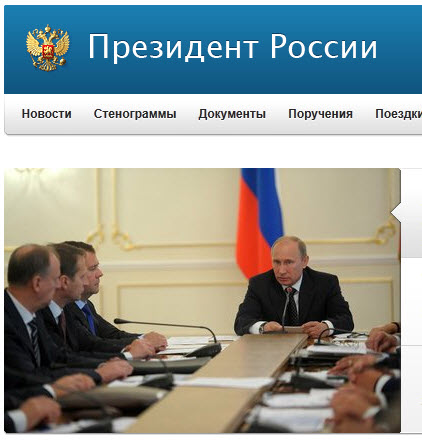
Gosudarstvennaia Duma: Ofitsial’nyi Sait
The official site of the contemporary State Duma provides considerable accessible information for the modern researcher in one site at http://www.duma.gov.ru/. As with the Presidential site it is possible to follow recent news concerning Duma legislation passed, decisions under consideration, and member activities. The news cycle can be browsed to 2002. Arguably the most useful section of the site concerns the composition and structure of the Duma. One can find the hierarchical structure that governs the Duma organization, as well as the members that make up the committees, commissions and Soviets that comprise the relevant bodies of this central legislative hierarchy, from the Duma President to the various central and as well as party staff bodies, or “apparaty.” The participants are also presented by their party structure, which is interactive, leading to a list of party members whose personal information is also available. The tab “About the State Duma” (O Gosudarstvennoi Dumy) is useful for researchers concerned with the past record and composition of the Duma, including the pre-revolutionary years and the post-Soviet era as well. Lengthy histories of past Dumas are accessible here, together with an article about the expansion of “parliamentarism” in Russia. Researchers can also learn where individual Duma members have traveled to recently and on what business, how to acquire accreditation to cover Duma sessions if you are from the press, contact information, and even addresses to Russian citizens explaining how to become a Duma representative and what vacancies exist. In another tab, “Legislation” ( Zakonodatel’naia Deiatel’nost’), it is possible to browse more closely what projects are currently on the slate, and call to request permission to enter the “listening” chamber and hear the debates taking place. Under “Representative Activities,” site visitors can follow selected meetings of Duma members, as well as read selected letters from the public together with some commonly asked questions. Other tabs permit closer inspection of international activities of Duma members. Finally, under the “Informational and Analytical Resources” tab, patrons can find access to a quarterly online information bulletin published by the Duma since 2006; a collection of Russian political publications, including position papers and publications by Duma members and of numerous specialized Duma commissions; other official publications of the Duma, as well as radio and television productions; lengthy minutes of Duma deliberations on press freedom; and, most importantly, access to the library of the State Duma, which includes an online public access catalog with several specialized databases including government journals, books on law and parliamentarianism, etc.

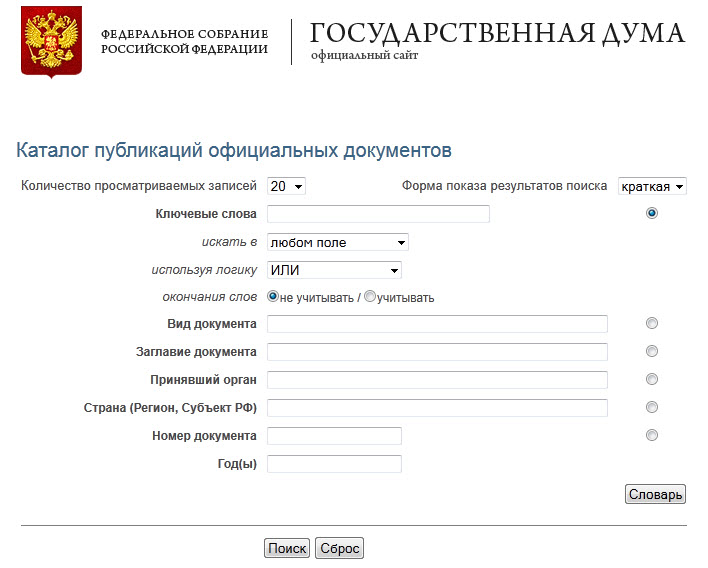
Ministry of Foreign Affairs of the Russian Federation
Similar to the official website of the Russian State Duma, the internet presence of the Ministry of Foreign Affairs is well-organized, thorough, and informative. The home site tracks most recent news concerning current developments in Russian foreign affairs, usually tracking the meetings, travels, and/or statements of Foreign Minister Sergei Lavrov. Here one can also find instructions for meeting representatives of the Russian diplomatic service, advise for Russian citizens traveling abroad, information concerning the structure, rankings, and different professional divisions within the Ministry’s overseas representatives, a video archive of interviews and press conferences dating back to 2004, and a host of other potentially useful information for researchers.

